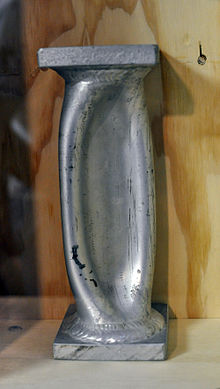Millibars
| Bar | |
|---|---|

A pressure of 700 bar flattened this length of aluminium tubing, which had a wall thickness of 5 millimetres (0.20 in)
|
|
| Unit information | |
| Unit system | Metric system |
| Unit of | Pressure |
| Symbol | bar |
| Unit conversions | |
| 1 bar in ... | ... is equal to ... |
| SI units | 100 kPa |
| CGS units | 1.0×106 Ba |
| US customary units | 14.50377 psi |
The bar is a metric unit of pressure, but is not approved as part of the International System of Units (SI). It is defined as exactly equal to 100,000 Pa, which is slightly less than the current average atmospheric pressure on Earth at sea level.
The bar and the millibar were introduced by the Norwegian meteorologist Vilhelm Bjerknes, who was a founder of the modern practice of weather forecasting.
Use of the bar is deprecated by professional bodies in some fields. The International Bureau of Weights and Measures (BIPM) lists the bar as one of the "non-SI units [that authors] should have the freedom to use", but declines to include it among the "Non-SI units accepted for use with the SI". The US National Institute of Standards and Technology (NIST) deprecates its use except for "limited use in meteorology" and lists it as one of several units that "must not be introduced in fields where they are not presently used". The International Astronomical Union (IAU) also lists it under "Non-SI units and symbols whose continued use is deprecated". As of 2004, the bar is legally recognized in countries of the European Union.
Units derived from the bar include the megabar (symbol: Mbar), kilobar (symbol: kbar), decibar (symbol: dbar), centibar (symbol: cbar), and millibar (symbol: mbar or mb). The notation bar(g), though deprecated by various bodies, represents gauge pressure, i.e., pressure in bars above ambient or atmospheric pressure.
...
Wikipedia
